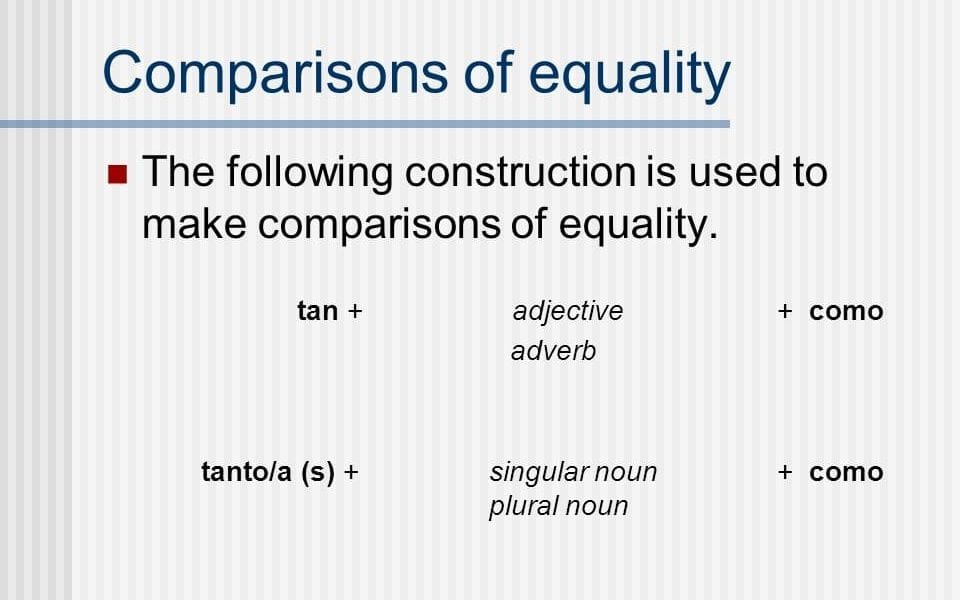In this grammar blog, we are going to talk about how to make comparisons of equality and inequality in Spanish. These comparisons are fairly simple to learn, but important all the same as they are used in all sorts of descriptions and are an essential part of everyday speech.
First we will be talking about comparisons of inequality, or how to compare two things that are not equal:
- We are not the same age.
- You are older than I am.
- Our suitcases do not weigh the same.
- My suitcase is heavier than yours.
In Spanish, we follow one of the following formulas:
- más/ menos + noun + que
- más/ menos + adverb + que
- más/ menos + adjective + que
Learn Spanish in Madrid
Learn Spanish in Mexico City
Learn Spanish in Santiago de Chile
Learn Spanish in Lima
Learn Spanish in Valencia
Learn Spanish in Barcelona
Learn Spanish in Toronto
Learn Spanish in Argentina
Let’s look at a few examples:
| Spanish | English |
| 1. Vos tenés más años (noun) que yo. | You are older than me. |
| 2. Teodora trabaja mas rápido (adverb) que Marcus. | Teodoro works faster than Marcus. |
| 3. Mi perro es más cariñoso (adjective) que el tuyo. | My dog is fatter than yours. |
When the comparative is followed by a number, we use de instead of que:
- Tengo más de 1.000 dólares en el banco.
- I have more than 1,000 dollars in the bank.
- Hay menos de treinta alumnos en la clase.
- There are less than thirty students in the class.
The only exception to the above rule is that when the sentence is negative, we use que with numbers to portray the similar meaning “only”.
| Positive | Negative |
| Tengo mas de 1.000 dólares. (I have more than 1,000 dollars.) | No tengo más que 1.000 dólares. (I have only 1,000 dollars.) |
| Hay más de treinta alumnos. (There are more than thirty students) | No hay más que treinta alumnos. (There are only thirty students in the class.) |
Now that we have talked about comparisons of inequality, we will be moving on to comparisons of equality.
When two things are being compared that have similar characteristics or features, we use comparisons of equality:
- The sequel was just as good as the original.
- I am as tall as my father.
When we want to make comparisons of equality using adjectives or adverbs, we use the following formula:


- tan + adjective/ adverb + como
| Spanish | English |
| La secuela es tan buena como el original. | The sequel was just as good as the original. |
| Soy tan alto como mi padre. | I am as tall as my father |
When we want to form comparisons of equality using nouns, we follow this formula:
- tanto(-a,-os,-as) + noun + como
| Spanish | English |
| Nacho tiene tanta plata como yo. | Nacho has just as much money as me. |
| Mi papá tiene tanto trabajo como vos. | My father has just as much work as you. |
| Yo tengo tantas plantas como mi hermana. | I have just as many plants as my sister. |
| Mi abuela tiene tantos perros como su hermana. | My grandma has just as many dogs as her sister. |
When we are forming comparisons using nouns, it is important to remember that we need to choose the corresponding form of tanto so that it agrees with the number and gender of the noun in the sentence:
- tanta plata
- tanto trabajo
- tantas plantas
- tantos perros
When we are comparing actions and there is no adjective present, we follow the following formula:
- verb + tanto + como
| Spanish | English |
| Mis hijos comen tanto como los tuyos. | My kids eat just as much as your kids. |
| Mi pollo pone tantos huevos como el de María. | My chicken lays just as many eggs as Maria’s. |
| Yo duermo tanto como vos. | I sleep just as much as you. |
Finally, when we are comparing actions and there is also an adjective, we follow this formula:
- verb + tan + adjective (masculine form) + como
| Spanish | English |
| Acá cocinamos tan rico como allá. | Here we cook just as good as there. |
| Vos no sos tan lindo como yo. | You are not as handsome as I am. |
| Yo no soy tan celoso como vos. | I am not as jealous as you are. |
Making comparisons is a very important part of the Spanish language and it is important to use them correctly when explaining or describing something. Luckily, as you can see, it is pretty easy and self explanatory once you learn the formula and the pattern to follow. I encourage you to practice making what you have learned in this grammar blog so that you are a master in no time and ready to move on to superlatives!




